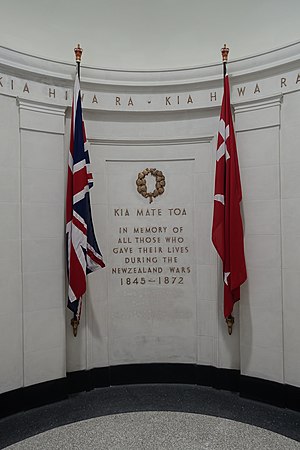
Back الحروب النيوزيلندية Arabic حروب نيوزيلاندا ARY شەڕەکانی نیوزیلاند CKB Neuseelandkriege German Guerra de las Tierras de Nueva Zelanda Spanish Zeelanda Berriko Gerrak Basque Maorisodat Finnish Guerres maories French מלחמות הקרקעות של ניו זילנד HE Peperangan Selandia Baru ID
| New Zealand Wars Ngā pakanga o Aotearoa | |||||||||
|---|---|---|---|---|---|---|---|---|---|
 Memorial in the Auckland War Memorial Museum for all who died in the New Zealand Wars. "Kia mate toa" translates as "fight unto death" or "be strong in death", and is the motto of the Otago and Southland Regiment of the New Zealand Army. The flags are the Union Jack and the flag of the Māori defenders of Gate Pā. | |||||||||
| |||||||||
| Belligerents | |||||||||
| Māori iwi | |||||||||
| Strength | |||||||||
| 18,000 (peak deployment) | 5,000 (peak deployment) | ||||||||
| Casualties and losses | |||||||||
| 745 killed (including civilians) | 2,154 killed (including civilians)[1] | ||||||||
The New Zealand Wars took place from 1845 to 1872 between the New Zealand colonial government and allied Māori on one side, and Māori and Māori-allied settlers on the other. They were previously commonly referred to as the Land Wars or the Māori Wars,[2] while Māori language names for the conflicts included Ngā pakanga o Aotearoa ("the great New Zealand wars") and Te riri Pākehā ("the white man's anger").[2] Historian James Belich popularised the name "New Zealand Wars" in the 1980s,[3] although according to Vincent O'Malley, the term was first used by historian James Cowan in the 1920s.[4]
Though the wars were initially localised conflicts triggered by tensions over disputed land purchases, they escalated dramatically from 1860 as the government became convinced it was facing united Māori resistance to further land sales and a refusal to acknowledge Crown sovereignty. The colonial government summoned thousands of British troops to mount major campaigns to overpower the Kīngitanga (Māori King) movement and also conquest of farming and residential land for British settlers.[5][6] Later campaigns were aimed at quashing the so-called Hauhau movement, an extremist part of the Pai Mārire religion, which was strongly opposed to the conquest of Māori land and eager to strengthen Māori identity.[7]
At the peak of hostilities in the 1860s, 18,000 British Army troops, supported by artillery, cavalry and local militia, battled about 4,000 Māori warriors[8] in what became a gross imbalance of manpower and weaponry.[9] Although outnumbered, the Māori were able to withstand their enemy with techniques that included anti-artillery bunkers and the use of carefully placed pā, or fortified villages, that allowed them to block their enemy's advance and often inflict heavy losses, yet quickly abandon their positions without significant loss. Guerrilla-style tactics were used by both sides in later campaigns, often fought in dense bush. Over the course of the Taranaki and Waikato campaigns, the lives of about 1,800 Māori and 800 Europeans were lost,[5] and total Māori losses over the course of all the wars may have exceeded 2,100.
Violence over land ownership broke out first in the Wairau Valley in the South Island in June 1843, but rising tensions in Taranaki eventually led to the involvement of British military forces at Waitara in March 1860. The war between the government and Kīngitanga Māori spread to other areas of the North Island, with the biggest single campaign being the invasion of the Waikato in 1863–1864, before hostilities concluded with the pursuits of Riwha Tītokowaru in Taranaki (1868–1869) and Rangatira (chief) Te Kooti Arikirangi Te Turuki on the east coast (1868–1872).
Although Māori were initially fought by British Army forces, the New Zealand government developed its own military force, including local militia, rifle volunteer groups, the specialist Forest Rangers and kūpapa (pro-government Māori). As part of broader Australian involvement in the wars, the Colony of Victoria deployed its naval forces, and at least 2,500 volunteers formed contingents that crossed the Tasman Sea and integrated with the New Zealand militia.[10][11] The government also responded with legislation to imprison Māori opponents and confiscate expansive areas of the North Island for sale to settlers, with the funds used to cover war expenses;[12][13] punitive measures that on the east and west coasts provoked an intensification of Māori resistance and aggression.
- ^ "End of the New Zealand Wars". New Zealand Ministry for Culture and Heritage. Retrieved 16 April 2013.
- ^ a b Keenan, Danny (20 June 2012). "New Zealand wars – New Zealand wars overview". Te Ara: The Encyclopedia of New Zealand. Retrieved 23 March 2022.
- ^ The end of the war (video). Landmark Productions. Retrieved 24 March 2022 – via Te Ara.
- ^ O'Malley, Vincent (2019). The New Zealand Wars Nga Pakanga o Aotearoa. Bridget Williams Books. p. 29. ISBN 9781988545998.
- ^ a b King, Michael (1977). Te Puea: A Biography. Auckland: Hodder and Stoughton. p. 26. ISBN 0-340-22482-7.
- ^ Dalton, B.J. (1967). War and Politics in New Zealand 1855–1870. Sydney: Sydney University Press. p. 179.
- ^ Belich, James (1986x). The New Zealand Wars and the Victorian Interpretation of Racial Conflict (1st ed.). Auckland: Penguin. pp. 204–205. ISBN 0-14-011162-X.
- ^ Belich, James (1986a). The New Zealand Wars. Auckland: Penguin. pp. 126–133. ISBN 0-14-027504-5.
- ^ Belich 1986a, pp. 24–25.
- ^ Hopkins-Weise, Jeffrey Ellis (2004). Australian Involvement in the New Zealand Wars of the 1840s and 1860s (PDF) (PhD). Brisbane, Qld.: University of Queensland, pp. 313–318. Retrieved 29 February 2024.
- ^ 'New Zealand Wars 1845–1864' https://guides.slv.vic.gov.au/colonialforces/newzealandwars (Victoria State Library)
- ^ Belich 1986a, p. 126.
- ^ Dalton 1967, pp. 181–182.